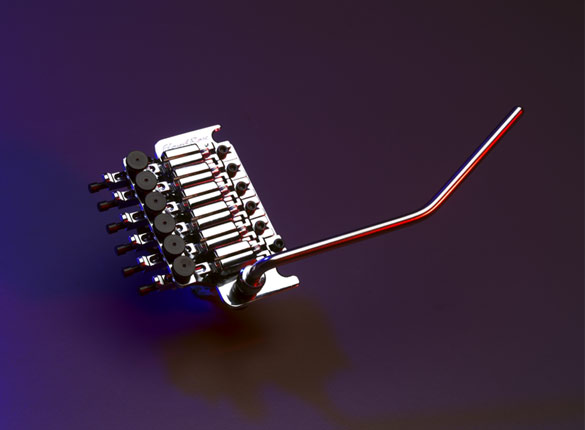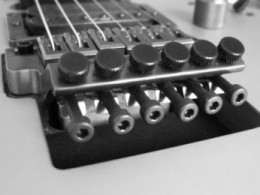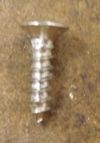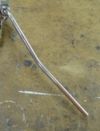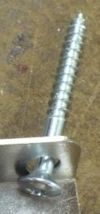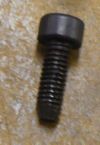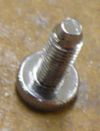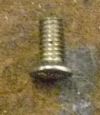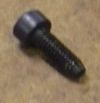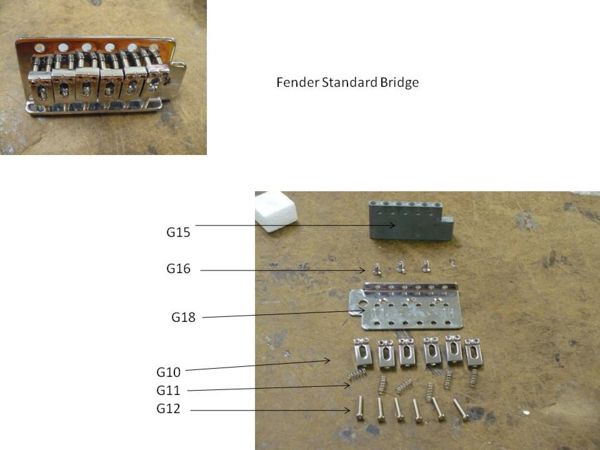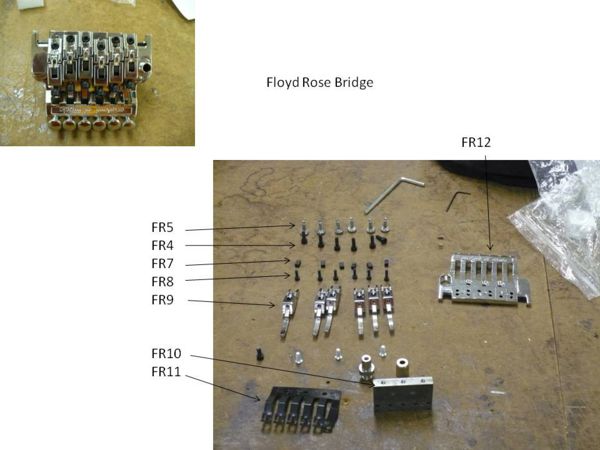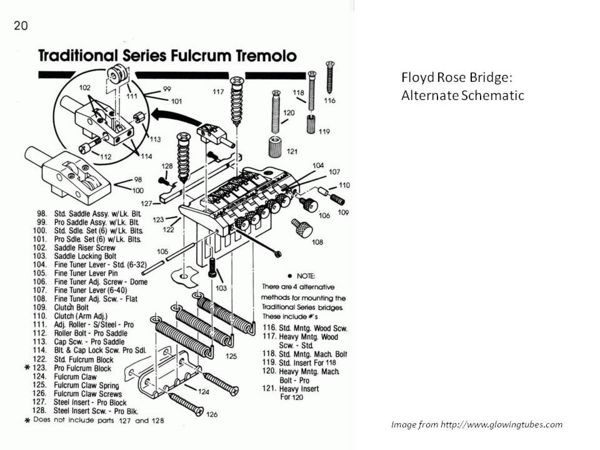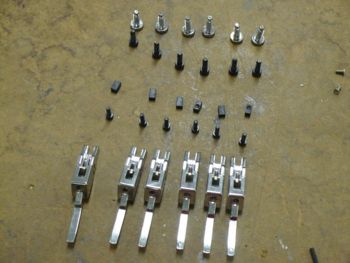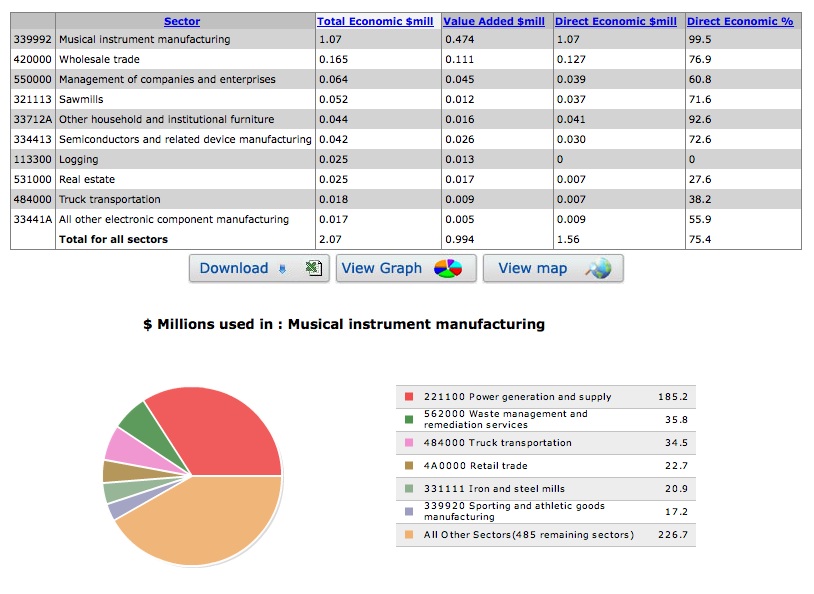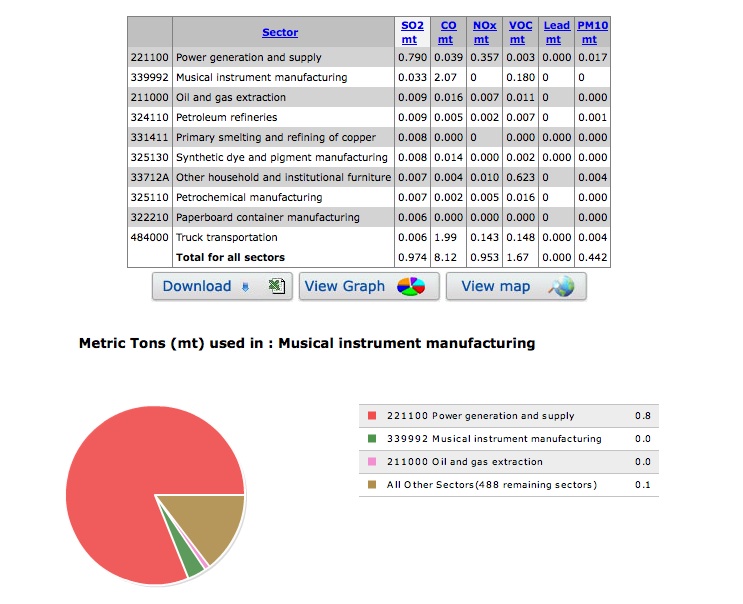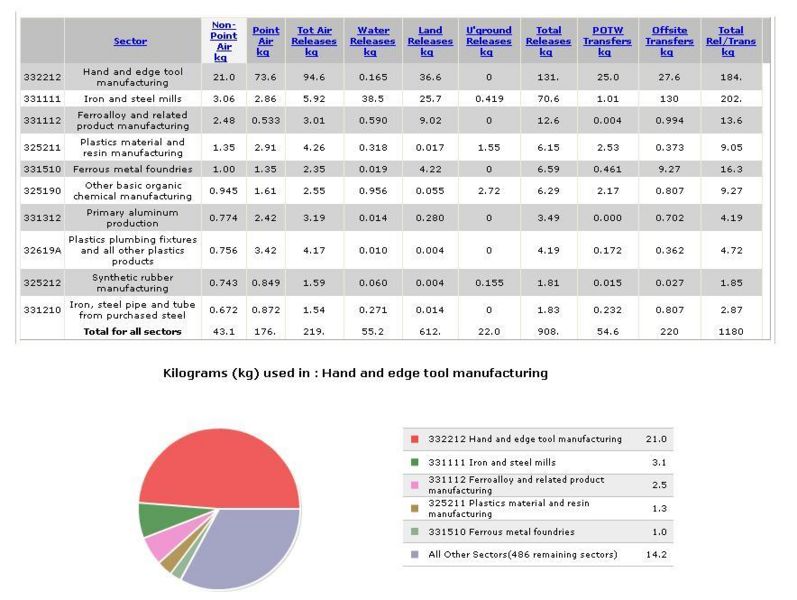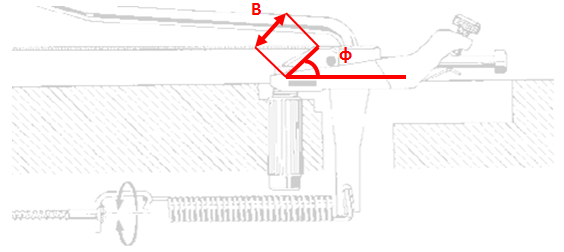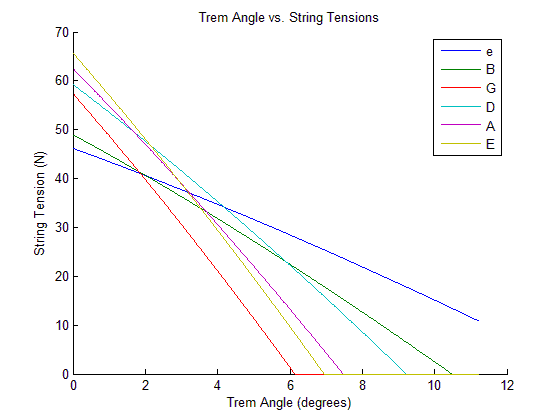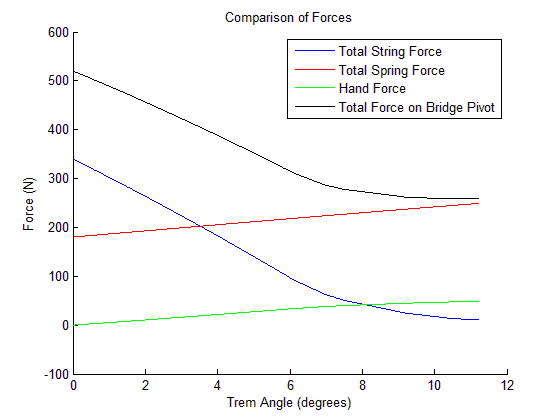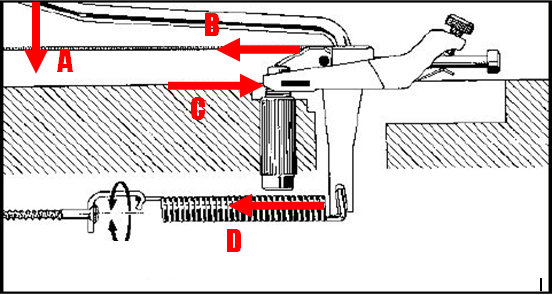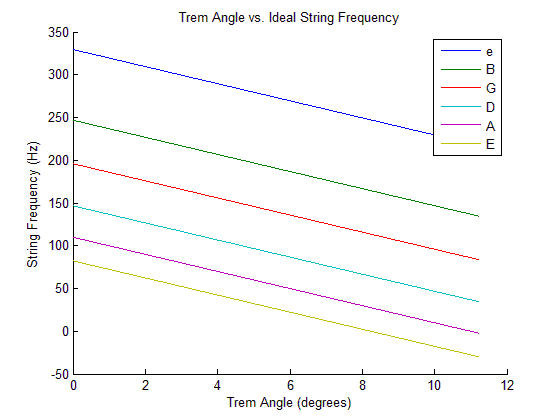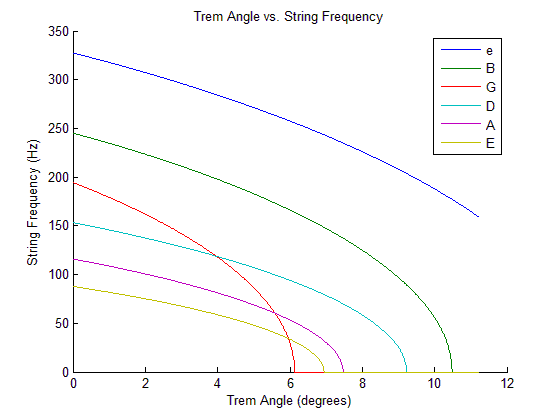Guitar bridge
From DDL Wiki
Contents |
Executive Summary
The electric guitar created a new genre of music, Rock and Roll, by allowing bands to expand the range of sound that they could create. Allowing guitarists to further experiment with sound will enable the continued evolution of music, and drive instrument sales as amateurs imitate the latest techniques they see on stage. The bridge on an electric guitar is a piece of metal that anchors the strings to the body, and holds them up to the correct height so that they can be strummed. On some electric guitars, the bridge serves the additional purpose of allowing the guitarist to change the pitch of notes produced by the guitar. This effect is called tremolo. Two bridge designs that allow this are the Fender bridge, and the Floyd Rose bridge. Changing the pitch is accomplished by pushing a lever attached to the bridge. The bridge pivots, changing the tension, and therefore the pitch of the strings.
These bridges are simple to manufacture, but can be difficult to assemble and install. This is a problem for one major stakeholder, the guitar manufacturers. By using and disassembling both bridge designs, we were able to discover several major design flaws, including trouble maintaining tune, and rapid wear of the pivot points. These flaws present everyday headaches for the two main groups of users, amateur guitarists, and professional guitarists. Through our quantitative analysis, we confirmed that these problems are not the fault of faulty manufacturing, but in fact are inherent in the design. The environmental impact of a guitar bridge is very low, as they require no fuel, electricity, or maintenance, and usually last the life of a guitar, or many decades. The most important things we should consider addressing in the future are the design flaws that cause every day usability issues to guitarists, since guitar bridges are already optimized for easy manufacture, assembly, and environmental impact.
Stakeholders and Needs
There are several primary stakeholders for this product, the manufacturers, suppliers, the novice users, and high-end users. There is enough variety in the market today that any major changes or improvements could be adopted competitively. While there are many guitar bridge designs on the market, we chose to consider the Fender and the Floyd Rose bridges, arguably two of the most popular among modern players. Even among guitars featuring these two designs, there is a wide spectrum of cost and quality. This can range from around a hundred dollars for a beginner's guitar to a few thousand for a high quality custom job.
The major needs for manufacturers are within the design specifications. While a manufacturer can make the part to whatever their clients ask, an extra degree of precision can increase labor costs by an order of magnitude. The raw materials are all common and fairly low cost, mostly stainless steel and occasionally brass. Another issue for manufacturers is assembly. The bridge itself is a moderately complex assembly with many parts to fit together, as well as fitting the bridge to the guitar and mounting the strings. These delicate operations add many operations to the assembly process, making it more expensive. One particular worry is the tension springs that act to counter balance the strings. These springs, located under the rear panel, are very difficult to remove or install. Another issue is that the two common bridges require different mountings, meaning the parts are not readily interchangeable.
The suppliers primary concern is the saleability of the guitar and related products (amps, guitar straps, tuners, picks, ect.) and as a secondary concern the logistics of shipping the product from manufacturers to stores to customers. The product must fit the range of customers the supplier caters to (see below), and all of the related products should still be compatible with any new product on the market.
A novice user, for our purposes, is any user who does not play guitar at a professional level or for profit. While quality is important, cost is a significant limiting factor for their choices. Beginning guitarists will tend more towards a Fender bridge and overall lower quality of guitar, as the levels of precision for a high quality instrument will not have a pronounced effect unless the user has enough skill.
High-end users are professional musicians who will invest significantly more into the quality of their instruments, and for whom cost is less of an issue. These users will almost all use a Floyd Rose bridge, (or in some cases an electronic self-tuning guitar), high quality guitar components, and ofter even pay a large sum for custom detailing work. For some musicians it is common practice to have several guitars on hand and an assistant who will re-tune the guitars after each song.
Use of the Current Design
The primary function of a guitar bridge is to securely mount and elevate the guitar strings. It must be able to withstand high tension forces and vibrations while keeping a consistent tension in all of the springs. For electric guitars, there is the added function of the vibrato (mistakenly labeled "tremolo" by Leo Fender, a term which stuck), which moves the guitar bridge and changes the tension in the springs. This produces a long wavering sound used in many performances.
There are two primary designs among guitar bridges. The first is the classic Fender model, a simple bridge developed in the 1950's which locks the springs in place and has a tremolo bar to deflect the bridge and alter the pitch of the strings. An improvement upon the Fender bridge is the Floyd Rose, developed in 1977. it features a floating bridge which improves the range of motion while keeping the guitar in better tune.
How the Current Design Functions
Both the Fender and Floyd bridges function in a very similar manner. The bridge holds the string in securely place to maintain tension. The tension can be adjusted with tuning knobs at the top of the guitar neck. The bridge is connected with a pivot at the top edge, with springs on the underside to counteract the tension from the guitar springs. A tremolo bar is attached to the bridge to alter the angle of the bridge, putting slack into the strings and changing their vibrations to alter the instrument's pitch. This slackening and tensioning of the springs causes the instrument to come out of tune as the tremolo is used. There are two primary differences in function between the Fender and the Floyd Rose. The Floyd Rose has a greater freedom of motion, both in the amount of change that can be caused and the rate at which the tension changes. The Floyd Rose also has the benefit of keeping the strings in tune longer than the Fender, as it includes clamps to securely hold the strings at either end of the bridge.
The manual operation of the guitar is straightforward, but skilled use requires significant dexterity. The guitar is most often supported either with a shoulder strap of by the player's leg while seated. The guitar is held with the left hand on the bridge, used to finger the frets. By pressing individual strings against the bridge the string is shortened to change the pitch. the right hand strums the strings, or uses a pick to pluck individual notes. The right and also is used to control the tremolo bar. While the strings are vibrating after being strummed, the right hand shifts to the bar and presses it inward towards the user's body. The slackening of the strings causes the pitch to drop, and a back and forth motion of the tremolo causes a wavering quality in the notes. This effect can not be sustained for extended periods as strumming the strings and pressing the tremolo cannot be performed simultaniously.
List of Parts with Functions and Illustrations
The guitar’s bridge assembly contains 18 unique parts, including two main components of the guitar, the neck and the body. Of those, 6 unique parts make up the standard Fender Bridge. The Floyd Rose bridge contains unique 12 components. Most parts in both assemblies were made out of metal, either steel or brass. These metal parts were for the most part cast, though some of the flat pieces like the spring in the Floyd Rose bridge were stamped. Casting would be a fairly cheap way to produce these metal parts, and in a guitar like the one we dissected, which is made to be low cost, price of manufacturing would be a major factor. In a more expensive guitar, it is likely that these pieces would have been machined, both because the number of guitars being manufactured is smaller, and also because the quality of the parts would be higher with the increased precision of machining, be it by hand, or CNC.
The majority of the parts in both bridges are made out of metal. This is at least partially because of the strength needed to withstand the forces placed on the strings, and the entire bridge. Certain pieces, like the strings themselves and the sustain block, are made the way they are to achieve certain acoustic properties. There are most likely many pieces of the bridge that could be made with a lighter metal, like aluminum, but this would change the acoustic properties of the guitar. Additionally, because the body is made of wood and the guitar is aimed at a low cost market to begin with, weight is likely not a factor given much weight when design decisions are made.
Fender Guitar Parts List
Floyd Rose Parts
Assembly Diagrams
DFMA
Design for Manufacture (DFM)
DFM allows for the design of products while reducing manufacturing cost and ameliorating product quality. Through the process of product dissection, it became apparent the different components of the system, the materials that were utilized, and the manufacturing process used for fabrication.
The Fender bridge that came with the guitar contained 6 different parts (not including the guitar assembly itself). Leo Fender, designer of the Fender bridge, as well as many other guitar related technologies, designed his bridge to be easy and cheap to manufacture, by using few parts in easy to manufacture shapes. In contrast, the Floyd Rose bridge contains six more parts (12 in total). The number of parts in any design should be minimized as much as possible without adding too much complexity to the remaining pieces. The reasoning behind this is that it is a great savings and it makes the overall design simpler in most cases. In the case of the Floyd Rose bridge, the extra parts are necessary for increased functionality. In a good design, functionality and simplicity of manufacture have to balance each other out.
In both designs, about a third of the unique components were standard screws. In terms of total parts count, screws accounted for 2/3 to 3/4 of the total number of parts. This standardization drastically reduces the price of the overall assemblies and makes it easier on the user for proper maintenance. The quality of standardized parts is usually higher than if it were manufactured independently and the cost per part is much lower due to mass production as well as savings on design costs.
Most of the pieces are produced from metal, specifically steel and brass. The most economical way to manufacture these pieces is by casting, as opposed to machining the parts. Casting can come in different forms, the most prominent being sand casting, die casting, and investment casting. The one used depends heavily on how many units are produced, the complexity of the part, and the mass of each component. Economic batch size is defined as the number of parts at which a certain process becomes more economical than its competitors. For instance, sand casting has an economical batch size from 1-3,600 while die casting is 3600 and beyond. However, a more limiting case for our design is the relatively small pieces being produced. For instance, the whammy bar for the original bridge weighs only 10.33g. Many of the bridge pieces are required to fit together with tight tolerances. With these manufacturing restrictions, it becomes much more economical to use investment casting, or die casting. In the case of the Floyd Rose bridge, Floyd Rose uses die casting to make most of the non-screw parts of the bridge. Leo Fender initially designed his bridge to use all stamped parts except for a single die-cast sustain block. This allowed Fender to keep the cost down on manufacturing. Over the years, Fender has switched several of its parts over to die-casting to improve the quality, and because the larger quantities required make die-casting a more economical option.
Design for Assembly (DFA)
DFA has very similar restrictions as that of DFM. Generally, you want to minimize as many parts as possible. In some respect, this is a major flaw in both bridge designs so far. The number of screws and fasteners used greatly reduces the assembly time of these products. Given the amount of parts used, it is fair to assume that these bridges are assembled either via manual assembly or automatic assembly, but not by robotic assembly.
Assembly requires human labor because of the number of dexterous operations required, but because the labor is not particularly skilled, these bridges are probably assembled either in China, in large quantities, or at the guitar factory, as needed. Assembly of a Fender Bridge probably takes less than a minute for a practiced worker with a powered screw driver. The Floyd Rose bridge probably requires 2-3 minutes of assembly time, as it has many more parts, which must be assembled in a specific order. Because of the short amount of time required to assemble the bridges, assembly is probably not a major cost factor except for the cheapest bridges.
FMEA
Failure Mode and Effects Analysis (FMEA) is a crucial tool in determining if a particular component in a system will fail (in terms of the customer's requirements). By looking at each piece, we can rate the severity of a failure (S), the probability that it will occur (P), and the likelihood that the customer would detect the failure (D). The severity of failure is rated between 1-10, 1 being the effect is not noticed by the consumer, while 10 is hazardous. Probability of occurence is also rated from 1-10, 1 being extremely remote while 10 has an extremely high chance of occurring. Finally, detection is rated from 1-10 with 1 being almost certain to detect and 10 being no chance of detection whatsoever. With these three factors, we can multiply them together to achieve a total risk priority number (RPN) which can range from 1-1000 (1000 being the greatest risk). Below is a table outlining each part.
Fender Failure Mode Analysis
| Item & Function | Failure Mode | Effects of Failure | S | Causes of Failure | O | Design Controls | D | RPN | Recommended Actions |
|---|---|---|---|---|---|---|---|---|---|
G1 Back Panel Cover Screw
| Screw holes may become stripped with frequent removal | Back panel no longer secure, lack of panel could cause harm to bridge internals or user | 4 | Screw holes become stripped | 4 | Test number of screw/unscrew cycles before failure on test guitars | 1 | 16 | Use metal inserts, or a latch system instead of wood screws on higher end guitars |
G2 Back Panel Cover
| Back panel may break when large amounts of pressure are put on it | Without back panel, the bridge mechanism can become fouled on user's clothing, may pinch user | 4 | Plastic plate cracks | 1 | Test force necessary to break back pannel | 2 | 8 | Use stronger plastic back plate, or a plastic/metal plate |
G4 Springs
| When springs removed for servicing, may shoot off | Harm to guitar, or user | 9 | Springs not adequately anchored | 3 | Measure spring tension at factory | 3 | 81 | Design springs to be easily removable, or create anchor cable to prevent spring from flying away (like a garage door spring cable) |
G5 Whammy Bar
| Shear failure at base | Broken handle, leading to an inability to use tremolo function without replacement. | 7 | Bar not strong enough near base | 2 | Test for imperfections using x-ray | 7 | 98 | Design bar to be thicker at base, where forces are greatest |
| Hard to tell if bar is inserted correctly | 3 | None (design flaw) | 1 | 21 | Design bar so it is difficult to insert incorrectly | ||||
G6 Bridge Mounting Screws
| With excessive use, the screws may become lose | Lose bridge, resulting in tuning problems | 3 | Bridge screws not tight | 4 | Measure screw tightness at factory | 2 | 24 | Use special screws designed not to work lose with operation of the bridge |
Floyd Rose Failure Mode Analysis
| Item & Function | Failure Mode | Effects of Failure | S | Causes of Failure | O | Design Controls | D | RPN | Recommended Actions |
|---|---|---|---|---|---|---|---|---|---|
FR1 Whammy Bar
| Shear failure at base | Broken handle, leading to an inability to use tremolo function without replacement. | 7 | Bar not strong enough near base | 2 | Test for imperfections using x-ray | 7 | 98 | Design bar to be thicker at base, where forces are greatest |
| Hard to tell if bar is inserted correctly | 3 | None (design flaw) | 1 | 21 | Design bar so it is difficult to insert incorrectly | ||||
FR2 Springs
| When springs removed for servicing, may shoot off | Harm to guitar, or user | 9 | Springs not adequately anchored | 3 | Measure spring tension at factory | 3 | 81 | Design springs to be easily removable, or create anchor cable to prevent spring from flying away (like a garage door spring cable) |
FR8 Clamp Screw
| Screw head becomes worn | Becomes impossible to unscrew screws, or change strings | 3 | Screw metal too soft | 3 | Measure screw hardness at factor | 2 | 18 | Use stronger metal for screws, or use screw head type more resistant to wear (Torx) |
FR11 Tuner Spring
| Spring bent when user services guitar | Spring provides inadequate pressure on tuners | 6 | Spring too easy to access | 3 | None (design flaw) | 1 | 18 |
|
| Spring too weak | 3 | None (design flaw) | 1 | 18 | Redesign spring to be thicker stamped piece | ||||
FR12 Baseplate
| "Knife Edges" become dull with use | Friction at pivot point increases, bridge ceases to return to pitch correctly. | 5 | Knife Edges not hard enough | 1 | Batch test knife edges for hardness | 3 | 15 | Use higher grade steel for knife edges |
| Too much pressure on knife edges | 8 | Design flaw, need pivot mechanism with larger contact area to spread pressure | 1 | 40 | Redesign pivot mechanism |
Conclusions
From our FMEA analysis, it becomes obvious that because the Fender and Floyd Rose bridge share many design features, they also share many failure points. The Floyd Rose bridge is designed to improve on the Fender design, but most of these improvements have to do with everyday use, instead of failure points. Since there are several severe failure points on both bridges, it would make sense for a new design to incorporate fixes.
Many of the failure points on the guitar bridges do not have to do with material failure, but instead are the result of design flaws and/or user error. This fact makes it difficult to judge the "Dectectability" factor of the SOD method for analyzing failure modes. In cases where the failure is due to design problems or user error, we chose to use a detectability factor of 1, because all bridge ship with the potential problem.
The one failure point that stands out on both bridges is the possibility of the springs flying off the guitar when the user tries to remove them. These springs have the potential to cause a good deal of damage, both to the guitar (scratched paint), and to the user (spring in the eye). This failure point is also one of the easiest problems to fix. It would be easy to implement a safety cable similar to those used in garage door springs, to catch the spring when it is released from its mounting points.
DFE
Design for Environment (DFE) is a very important component of the entire design process given the current state of affairs in the world today. We are experiencing a dramatic increase in carbon dioxide production, leading to global warming which effects ecosystems in potentially catastrophic ways. Engineers need to be able to quantify the impact their products have on the world and on the environment. In order to do this efficiently, a tool is utilized called Economic Input-Output Life Cycle Assessment (EIOLCA) which is a quick and easy alternative to the more traditional Process-based Life Cycle Assessment. This tool allows engineers the ability to investigate, estimate, and evaluate the environmental burdens caused by a material, product, process, or service throughout its life span. Since a guitar bridge, once assembled, is not very detrimental to the environment, this analysis will focus on the production and transportation of the product.
Economic Activity
An injection of $1 Million Dollars into this sector creates a net influx of $2.07 Million in all sectors. This is distributed among many different sectors ranging from transportation to trade.
Air Pollutants
For every $1 Million Dollars spent in this sector, 12.159 Tonnes of air pollutants are produced, mostly coming from the power generation and supply of the manufacturing process. Air pollutants are detrimental to one's health and can ruin certain ecosystems. The most abundantly produced air pollutant in our analysis is carbon monoxide. CO effects the air quality in the atmosphere and exposure to it can produce a spectrum of negative health effects such as shortness of breath and dizziness.
Greenhouse Gases
468 MTCO2E (Metric Ton CO2 Equivalent) are produced mainly from the power generation sector. It are these gases that contribute to the warming of the Earth due to the Greenhouse Effect.
Toxic Releases
Conclusions
A guitar bridge requires no lubrication or maintenance, nor does it require fuel. The lifetime of a guitar bridge is the lifetime of the guitar. The first electric guitars built in the 1950's are still going strong, so there is no reason to assume that modern, more refined guitars shouldn't last centuries, if the most basic care is taken with them. Guitars, and most other musical instruments, are part of a thriving used market. Guitars that are bought are rarely discarded, but instead sold to other musicians, minimizing the amount of recycling going on. Because of these factors, the environmental impact of a guitar bridge can be assumed to be almost identical to the environmental impact of its manufacture.
For our EIO-LCA, we chose to model our guitar bridge as "musical instrument manufacturing". We believe this is accurate because the bridge is a musical instrument piece, and the companies that manufacture them have their own factories, instead of using contracted factories in the general metal production sector. The bridge is not a typical musical instrument, as it is made entirely of metal, instead of wood, plastic, and metal. However, we believe that the musical instrument sector is still the best match.
Our results show that the majority of the pollution emitted during the production of our product is from power generation. This makes sense, since metal casting requires large amounts of power to heat the metal to melting point, and for the industrial equipment to handle the molds. A significant amount of pollution is generated during musical instrument manufacture. This comes from things like toxic paint fumes, and processes that use hazardous chemicals like electroplating.
Guitar bridges are easy to recycle. The parts are all easy to disassemble (screws only), and all parts are made of relatively pure (if not high grade) metals, including steel and brass. Easy disassembly and high amounts of metal make guitar bridges very low cost and high return to recycle, providing users with incentive to recycle bridges. We do not see recycling as being a major issue, especially when considering the fact that very few guitars actually get scrapped.
The fact that pollution is released during manufacture is unavoidable. When we considered the amount of pollution released per bridge, we found that guitar bridges are actually quite eco-friendly. If a $50 per metric ton of CO2 equivalent pollution tax were implemented, each bridge would be taxed at $0.47. This product is meant to last a lifetime, so if we consider the environmental impact spread over 20 years, then the tax would be less than $0.03 per year.
Mechanical Analysis
Summary of Quantitative Analysis
In our quantitative analysis, we chose to analyze the forces acting upon the bridge. As an offshoot of this, we were also able to analyze the effect of using the bridge on the pitch of the strings. We determined that although each of the components of the guitar bridge act in an easily predictable linear fashion, the complex combination of all the factors combine together into a very non-linear system. The main independent variable of our device is the angle that the bridge is depressed by the guitarist. We called this variable theta.
For our analysis, we used a simplified, but relatively accurate model of the guitar bridge. The Floyd Rose bridge is functionally very similar to our bridge model. The original Fender bridge has a number of design flaws which introduce large unpredictable changes to the forces on the strings, which we could not model easily. Consider our model a “best case scenario” for a pivoting bridge. Any tuning problems with our model would be exacerbated, not alleviated in a real world implementation.
Assumptions
1. The strings are fixed at both the bridge and the nut. Without this assumption, the unpredictable shifting of the strings at the tuners and ball-ends introduces additional tuning problems. The Floyd Rose bridge employ’s clamps at the bridge and nut which fix the strings.
2. Strings behave as steel linear springs. Strings are made of nickel steel alloys. Since the exact recipe for the steel is a closely guarded industry secret, we assumed the properties of the strings match that of standard stainless steel. The density of stainless steel is 7800 kg/m3 and the elastic modulus is 200 GPa.
3. The guitar neck and body do not deform. In a real guitar, the body and neck are made of wood, and deform under the tension of the strings. This deformation is very small, and we chose to ignore it for simplicity.
4. Small Angle Assumption. We meant this not in the trigonometric sense (sin(angle) = angle, and cos(angle) = 1), but in the sense that the bridge is only meant to function at relatively small values of theta. We assumed a maximum angle of 12 degrees. Beyond this angle, the the strings are all completely limp, and at some point, the bridge would break.
5. We assumed that the strings used are of the common “8-42” variety. The string diameters are 8, 11, 15, 22, 30, and 42 thousandths of an inch. The thickest three strings are thinner steel cores wrapped with wire, which provide increased linear mass without making the strings too stiff to vibrate.
| String | Diameter (inches) | Diameter (m) | Core Area (m^2) | Tension (N) | Pressure (Pa) | Deflection (mm) | Standard Tuning (Hz) | Linear Mass (kg/m) |
|---|---|---|---|---|---|---|---|---|
| e | 0.009 | 0.000229 | 4.10e-8 | 46.1 | 1.13e9 | 5.63 | 329.6 | 0.0001673 |
| B | 0.011 | 0.000279 | 6.13e-8 | 49.0 | 7.99e8 | 3.99 | 246.9 | 0.0003163 |
| G | 0.016 | 0.000406 | 12.97e-8 | 57.4 | 4.42e8 | 2.21 | 196 | 0.000588072 |
| D | 0.024 | 0.000330 | 8.56e-8 | 59.3 | 6.93e8 | 3.46 | 146.8 | 0.001084068 |
| A | 0.032 | 0.000381 | 11.40e-8 | 62.5 | 5.48e8 | 2.74 | 110 | 0.002033498 |
| E | 0.042 | 0.000406 | 12.97e-8 | 65.7 | .07e8 | 2.53 | 82.4 | 0.003809595 |
Table 1: Properties Assumed (or calculated) of Guitar Strings
Figure 1: The Simplified Guitar Model Used for Analysis
Figure 2: Close Up of Guitar Bridge with Assumptions for Analysis
| Symbol | Definition | Value |
|---|---|---|
| L | Length fo the guitar scale, from the nut to the bridge pivot. | 25 inches, or 0.635 meters |
| B | The length of hte bridge from the pivot point to the point where the strings make contact with the bridge. | 3/8 of an inch, or 0.01346962 meters |
| S | The length of the string. | Variable function (function of θ) |
| φ | The "at rest" angle of the bridge | 45 degrees |
| θ | The additional, user supplied angle to the bridge. | Independent variable |
Table 2: Variable Definitions
Determining the String Tension
Each string on the guitar is made out of a very thin wire of nickel steel. The wire is either made of solid steel, or a solid steel core wrapped in another coil of steel wire. This wrapping allows the string to have a relatively high mass, while remaining flexible, as a solid string of the same thickness would be very hard to pluck. The wires can be viewed as springs, since under standard guitar tuning, the strings stretch an appreciable amount. Although each string can be viewed as an ideal spring, the combination of the tension forces of all six strings on the bridge is a non-linear function when compared to the angle of the tremolo.
One cause of this non-linearity is the fact that for any string, its tension vs. bridge angle function is a piecewise function. The tension in the string decreases linearly as the bridge angle increases, but when the tension reaches zero, the string does not compress like an ideal spring would. Instead, the tension remains zero. When you add together all six string functions, the resulting total plots as a curve, not a straight line.
Derivation
The strings behave as springs. Therefore, we will use Hooke’s spring law to determine the tension.
Where F is the spring force, k is the spring constant, and x is the stretch or compression of the spring. To determine the force of a spring in preexisting tension, we can add a constant to the format:
Substituting the appropriate variables for the guitar problem gives us this equation.
T0 is the tension of the guitar strings in standard tuning.
kstring is the string constant of the string.
S(0) is the neutral length of the string.
S(θ) is the length of the strings when the bridge is at angle θ.
Further deviation from the expected linear result is caused by effect of the string diameter on the rotation of the bridge. The bridge can be idealized as a pulley, around which the string is wrapped. When the pulley turns, the string is wound or unwound. Each string is not infinitely thin, so the radius of the pulley is different for each string. Therefore, the uniform rotation of the bridge allows a different amount of additional slack for each string.
Figure 4: String Radius's Effect on Tuning
Forces and Moments
Overall, the predictions of our mathematical model match very closely our hands on experience with the guitar bridge. The mathematical model predicts a force of around 10 pounds to depress the bridge appreciably, which the mathematical model backs up. This force seems to be an appropriate amount for ease of use, as too little force would allow the bridge to detune by accident, and too much force would make it too difficult to use. All the members of our group (guitarists and non-guitarists alike) felt that the amount of force required to operate the bridge was appropriate. The forces in the springs, which serve to create a counter-force to that of the strings, was lower than we expected, being less than ½ the force of the strings when the bridge is in its neutral position. When dissecting the guitar, we found removal of these springs to be quite difficult, and originally attributed it to high tension in the springs. This initial impression seems to be incorrect, as each spring is under only 15 lbs of tension. The bridge pivot serves as the mounting point and pivot for the guitar bridge. As such, it is the location where large forces are most likely. This proved correct in our mathematical analysis. In its neutral position, the pivot had to provide 500 N of force, or almost 120lb. The area over which this force is provided is very small (a few square millimeters), meaning that the pressure there is astronomically high. Distributing this pressure would be a possible direction for this project to take, as the pivot point of the bridge is a frequent point of wear and breakage on guitars.
Derivation
Figure 6: Diagram of Bridge with Forces
Image from http://www.jemsite.com/tech/1setup.htm#step1 , taken from Ibanez Guitar Setup Booklet
| Variable | Description |
|---|---|
| A | Hand Force (User pushing on the lever) |
| B | String Tension |
| C | Pivot Force (at the mounting point) |
| D | Spring Tension |
Table 3: Force Definitions
The sum of the forces on the bridge can be expressed as such:
The sum of the moments on the bridge, summed around the pivot point, is as follows:
Where hbridge is 1”, lhandle is 5 ¾”, measured from the guitar.
String Frequency
An ideal guitar bridge would allow a guitarist to detune his guitar musically. This would mean that each string’s fundamental frequency would retain a linear relationship with the other strings. Such a bridge would have a frequency vs. bridge rotation graph similar to this one:
Figure 7: Ideal Angle vs. Frequency Graph
Using our mathematical model, we calculated the response of an actual guitar bridge, which looks like this:
Figure 8: Actual Angle vs. Frequency Graph
This graph shows that not only do the strings not behave linearly, but they also do not maintain a linear relationship to each other. This effect is especially noticeable on the G string of the guitar, which detunes much faster than the other strings. In practical terms, this means that the guitarist is not able to play chords when using the tremolo bridge of the guitar, as the strings no longer are in the same tune, so playing two of them together will sound dissonant. This limits the guitarist to only using the tremolo bridge for playing single notes, or chaotic dissonant noises. Being able to play chords and detune them musically would open up many musical possibilities currently not available to guitarists.
Derivation
In order to determine the frequency of the string, we need to know the length of the string as a function of the position of the bridge.
The length of the string is actually a use of the Pythagorean theorem, as can be seen in the illustration of our guitar model, the string is the hypotenuse of a triangle with sides formed by the guitar body, and the bridge. The height of the triangle is a function of the sine of angle of the bridge, and the thickness of the string. The length of the triangle is the sum of the length of the body, and the cosine of the angle of the bridge. We need to determine the linear mass of the string. The linear mass is the mass per length of string.
For the solid strings, this is easy to determine. For the wound strings, the linear mass is harder to determine. I used this formula, found at http://terrydownsmusic.com/technotes/StringGauges/STRINGS.HTM to determine the corrective coefficient to get the correct linear mass.
Where d0 is the total diameter of the string, and dcore is the diameter of the solid metal core.
The equation for a vibrating string is as follows:
Substituting the correct variables for the guitar example, the frequency of the string is a function of the length of the string, the tension, the linear mass, and where necessary, the corrective coefficient for linear mass. Note that for solid strings, the corrective coefficient is equal to 1.
Since S and T are actually functions of θ, the equation for frequency can be written in this form:
Using the equation and the string properties from Table 1, we were able to create the graph seen above.
Conclusion
Through our analysis, we discovered several things that will be useful to our future task redesigning the guitar bridge.
Firstly, the musicality of the strings when the bridge is used is not very good. The strings to not stay in tune relative to each other at all. This is not a small problem, but a fundamental issue with the current "rotational" tremolo design.
Secondly, the force required by the user to activate the bridge is about 50 N maximum. This is a very reasonable number, and should be our goal for any alternative designs we consider. The force of the springs on the bridge is similarly reasonable, and is not a design problem. The only force that is worryingly large is the force at the pivot points. Since this force is concentrated into a very small area, it has the potential to fatigue the metal very quickly. We might chose to design a bridge with a larger contact area for this force, which would improve the reliability of the bridge.
Team Member Roles
 |  |  | 
|
|---|---|---|---|
| Mike Harrison | Aaron Marks | Jonathan Kyle | Jeremy Ozer |
To complete the project, our team met to figure out how to work together to complete the report. We decided that the best way for us to go about this was to first do the dissection, then discuss our findings. After we discussed our results extensively, we decided to split the different aspects of the report in to sections, and assign the sections to group members. While each group member had his own sections to work on, we remained in communication and offered or requested assistance as necessary. Finally, once a complete draft of the report was done, we each check the report over in its entirety and offered feedback to the other group members on their sections. Although we each worked on separate aspects of the report, after the first draft was posted, all of us contributed to each section, making the final draft a complete group effort, rather than a combination of distinct ones.
Below are listed the team members, their roles and report sections.
Michael Harrison
Product Use Analyst
Stakeholders and Needs, Use of the Current Design, How the Current Design Functions, Powerpoint Presentation
Jonathan Kyle
Product Design Analyst
Aaron Marks
Parts Analyst
List of Parts with Functions and Illustrations, Powerpoint Design and Presentation
Jeremy Ozer
Quantitative Analyst, Team Record Keeper
Executive Summary, Mechanical Analysis, Team Member Roles
All
Future Plans
For the second design report, we are focusing on studying users of guitar bridges, and doing market research. To accomplish this, we will be conducting interviews with several local rock bands, as well as other guitarists from the area. For sales data, we plan on visiting local music stores and asking for any information the sales people and store managers might have about the types of guitars sold. We will also attempt to find information on guitar sales nation or world wide using the internet.
References
Carnegie Mellon University Green Design Institute. (2008) Economic Input-Output Life Cycle Assessment (EIO-LCA) model [Internet], Available from: <http://www.eiolca.net/> [Accessed 24 Sep, 2008]
Christie, R. "Guitar Tunings." Wikipedia. 16 Sept. 2007. Wikipedia. 18 Sept. 2008 <http://en.wikipedia.org/wiki/guitar_tunings#standard_tuning>.
Dee. "String Tension Charts." Jemsite: Ibanez JEM/UV Guitars & More. 19 Feb. 2008. Www.jemsite.com. 16 Sept. 2008 <http://www.jemsite.com/forums/f21/string-tension-charts-73846.html>.
Delavie, Ven. "The Hendrix Collection Photo Page 17." The Isle of Hendrix. Gobot.com. 23 Sept. 2008 <http://www.theisleofhendrix.gobot.com/photo6.html>.
Downs, Terry. "Design of Custom String Gauges." Terry Downs Music. 1 Nov. 1997. Terrydownsmusic.com. 16 Sept. 2008 <http://terrydownsmusic.com/technotes/stringgauges/strings.htm>.
EFunda, Inc. "General Properties of Steels." Efunda Engineering Fundamentals. 2008. Efunda. 17 Sept. 2008 <http://www.efunda.com/materials/alloys/alloy_home/steels_properties.cfm>.
"Floyd Rose Vibrato." GlowingTubes.com. 28 July 2008. GlowingTubes.com. 21 Sept. 2008 <http://www.glowingtubes.com/p/floydtuning.htm>.
Floyd Rose Inc. Floyd Rose Speedloader Tremolo. 7 Sept. 2005. Floyd Rose Inc., Oakhurst NJ.
Internet Guitar Database. "Guitar Intonation." Internet Guitar Database. 2007. Internet Guitar Database. 23 Sept. 2008 <http://www.igdb.co.uk/pages/guitar_setup/guitar_intonation.htm>.
Rubin, Edward. "Introduction to Engineering and the Environment." McGraw-Hill higher Education. 2001.
Setup Strat Bridge "bridge Setup" FGLO Free guitar lesson online <http://www.freeguitarlessononline.co.uk/fender-stratocaster-setup.html>
